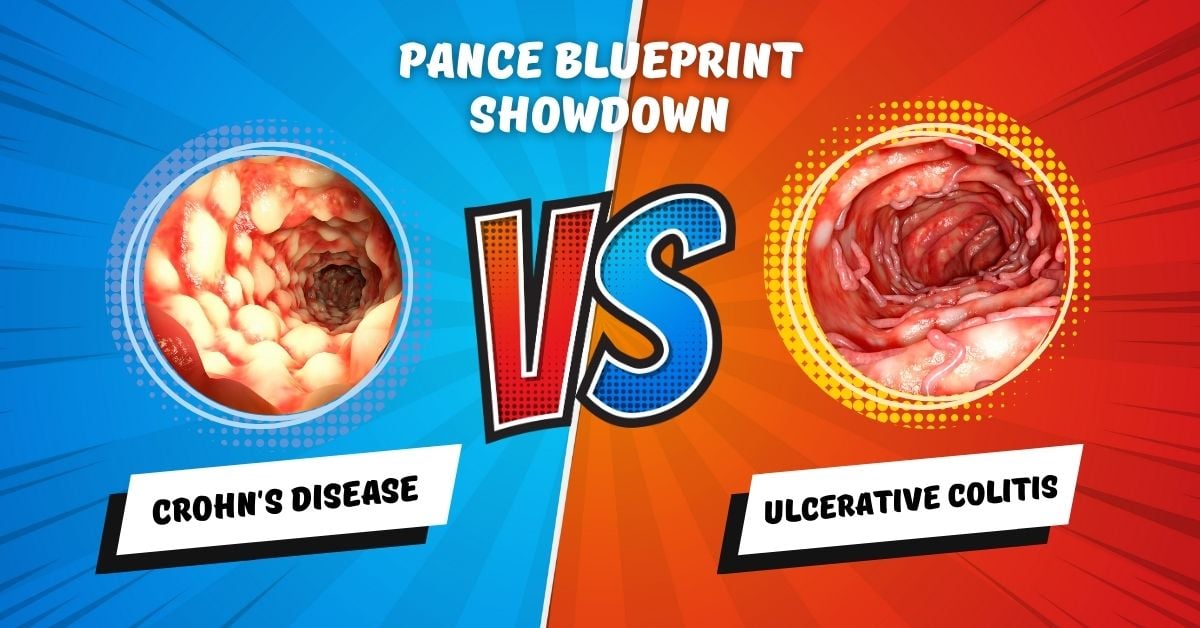Inflammatory bowel diseases (IBD), primarily Ulcerative Colitis and Crohn's Disease, are significant topics in the NCCPA PANCE Content Blueprint covered as part of the Gastroenterology and Nutrition System under the category of colorectal disorders.
These two conditions are also covered as part of your Internal Medicine EOR Topic List.
Their diagnostic similarities and relationship within the category of IBD is low-hanging fruit for exam writers, and it is extremely common to encounter questions on your PANCE, PANRE, and EOR exams that test your knowledge of IBD and ability to distinguish Crohn's disease from ulcerative colitis.
In this edition of our PANCE Blueprint Showdown, we delve into the critical components of IBD, spotlighting their unique features and distinguishing characteristics so you will have the knowledge you need to eliminate distractors and select the correct answer come exam day.
Crohn's Disease: The Digestive Tract Voyager
In contrast, Crohn's disease takes a more widespread approach, with inflammation potentially spanning the entire digestive tract - from mouth to anus. The most common site is the terminal ileum, but remember that Crohn's is rectal sparing.
Symptoms of Crohn's disease vary widely depending on the affected areas but commonly include non-bloody, watery diarrhea, abdominal pain, and oral mucosal aphthous ulcers. Crohn's inflammation is transmural, meaning it affects the entire thickness of the bowel wall, leading to complications like obstructions, abscesses, fistulas, and sinus tracts.
A key difference with UC is the presentation of "skip lesions," where inflammation occurs in patches separated by healthy tissue, leading to a cobblestone appearance of the bowel wall. The ASCA antibody test is an essential part of the Crohn's disease diagnostic toolkit.
Ulcerative Colitis: The Colon Conqueror
True to its name, ulcerative colitis is confined to the colon, with the rectum being the most commonly affected site. One of its defining characteristics is that it moves in an ascending fashion, starting from the rectum up to the ascending colon. Unlike Crohn's disease, ulcerative colitis doesn't go beyond the mucosa and submucosa layers of the colon wall.
Patients typically present with bloody, pus-filled diarrhea accompanied by rectal/lower quadrant pain, fever, and a sense of urgency. Diagnosis usually involves a barium enema and colonoscopy with biopsy, which show continuous inflammation extending from the rectum and loss of haustral markings and lumen narrowing, also known as the "lead pipe appearance." A characteristic lab finding is increased white blood cells (WBC), erythrocyte sedimentation rate (ESR), and anemia. The key player in UC diagnostics? The p-ANCA antibody test.
Chron's disease vs. Ulcerative colitis
| Crohn's disease | Ulcerative Colitis | |
| Site of involvement | Any area of the GI tract (rectal sparing) - the most common site is the terminal ileum | UC only involves the colon - the rectum is usually involved |
| Pattern of involvement | Skip lesions | Continuous |
| Diarrhea | Usually non-bloody watery diarrhea | Bloody |
| Severe abdominal pain | Frequent | Rare |
| Perianal disease | 30% of patients | No |
| Fistula | Yes | No |
| Endoscopic findings | Aphthoid and deep ulcers; cobblestoning | Erythematous and friable superficial ulceration |
| Radiographic findings | String sign of terminal ileum, RLQ mass, fistula, abscesses | Tubular (lead pipe) appearance resulting from loss of haustral folds |
| Histologic features | Transmural, non-caseating granulomas | Confined to mucosa and submucosa |
| Smoking | Worsens course | Protective |
| Serology | ASCA | pANCA |
Here are some of the key points to remember:
- Ulcerative colitis is confined to the colon, VS Crohn's disease can affect any part of the digestive tract.
- Ulcerative colitis typically causes continuous inflammation, VS Crohn's disease can cause patchy or skip-like inflammation.
- Ulcerative colitis only affects the inner lining of the colon, VS Crohn's disease can affect all layers of the colon wall.
- Ulcerative colitis is more likely to cause bloody diarrhea, VS Crohn's disease is more likely to cause abdominal pain, weight loss, and fever.
- The antibody tests pANCA, and ASCA can be helpful in distinguishing between ulcerative colitis and Crohn's disease. However, it is important to remember that these tests are not always accurate.
Ulcerative Colitis
- Presents with bloody puss-filled diarrhea, rectal/lower quadrant pain, fever, and urgency
- Confined to mucosa and submucosa (unlike Crohn's, not transmural)
- Inflammation isolated to the colon. The most common site is the rectum
- It affects the colon in an ascending fashion starting from the rectum up to the ascending colon - remember, ulcerative moves UP from the rectum to the ascending colon!
- Diagnosis by barium enema lead pipe appearance and colonoscopy with biopsy show continuous inflammation starting from the rectum and extending proximally with loss of haustral markings and lumen narrowing.
- Antibody test: Antineutrophil cytoplasmic antibodies (p-ANCA)
Crohn's Disease
- Distribution from mouth to anus and will commonly present with thickened bowel wall, cobblestoning, and “skip” lesions.
- Tends to be transmural vs. UC is limited to the mucosa and submucosa
- The most common site is the terminal ileum
- Non-bloody watery diarrhea
- Oral mucosal aphthous ulcers
- Obstruction, abscess, fistula, and sinus tracts are common
- Crohn's disease is rectal sparing
- Antibody test: +Anti-Saccharomyces cerevisiae antibodies (ASCA)
Ulcerative colitis and Crohn's disease are two important inflammatory bowel diseases that can be difficult to distinguish. However, by understanding the key features of each condition, you can better diagnose and manage your patients (and ace your boards)!
Stay tuned for our next PANCE Blueprint Showdown, where we continue to dissect essential medical knowledge for your exams and clinical practice.





